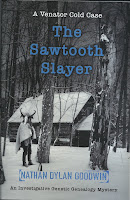Nathan Dylan Goodwin. The Hollywood Strangler. www.nathandylangoodwin.com, 2024.
With Goodwin's eagerly awaited Venator No. 3, the hidden presence of a years-ago psycho killer is conjured. LAPD detectives Marsden and Powers (I like the nod to Michael Connelly) are reviewing the cold case of the notorious Hollywood Strangler of the 1980s when they luck into an overlooked DNA sample for the killer. It's 2022 and the firm of choice for investigative genetic genealogy (IGG) is Maddy Scott-Barnhart's company, Venator, in Salt Lake City. Four highly skilled genealogists get to work on determining matches for the DNA, from submissions in an enormous database—people looking for new kin to help extend their ancestry—and tracing a minimum five generations of each match. Back then, or perhaps farther, will be a common ancestor for both the match and the killer. Tracing generations forward from that common point, "reverse genealogy," should produce potential candidates as the killer.
I make no pretense at being experienced with DNA research. But for some character reference and continuity, you might see my prior Venator reviews:
"Another Win for Goodwin!" February 2021
"Goodwin Fans Rejoice!" November 2022
Offsetting the floods of names and sources (unless you are a family historian yourself, you may feel engulfed), Goodwin deftly weaves the current lives of Maddy's diligent team into the mix. Most are exploring new personal relationships. Team member Becky is not on site, although she participates in the Strangler research; temporarily in Haiti, her undisclosed private mission worries Maddy. Becky's father had employed Michael, Maddy's long-missing husband, in business ventures that included some ties to Haiti. Maddy's reliable right hand, Kenyatta, is a Black single mom with a problem teen; Maddy's own domestic scene involves live-in care for her mom who is losing touch with reality. New member Reggie is an avid snowboarder, sharing apartment space with Hudson, the team's IT expert; Reggie urges Hudson to an online site for trans dating, so maybe he knows something we don't. Reggie also develops feelings for the Venator receptionist and general factotum, Ross—although hand-holding and lip-kiss greetings seem to be the only intimate bodily contact all these individuals have with each other. No pillow talk here!
Goodwin's attention to research detail is meticulous, medical forensics as well. Constructing fictional "trees" with appropriate sources is rather mind-boggling, never mind the headline topics he ticks via the team's private lives—homelessness, online dating, dementia, sexual abuse rings, military crimes, for a few. Yet to my mind, he over-stretches for inclusiveness, hitting multiple diverse elements of the human experience. Even with so many threads, tension is aptly built where it counts, including whether the strangler could still be alive. That is eventually determined, but I'm sorry that Goodwin—craftily but typically—leaves a few loose ends. We strongly hope a Venator No. 4 is already generating!
Pull quotes are mainly from the personal stories.
Bits
▪ "This case has been pulled up so many times in the twenty-seven years I've worked in RHD, and nobody has managed to crack it; it's the department's great white whale." (16)
▪ "To put it another way, we have about half the weight of a single grain of table salt of this guy's DNA left." (17)
▪ "Coming home?" he asked Reggie. "Or are you out with your mysterious date again, tonight?" (85)
▪ Kenyatta fought back against the emotion rising inside her. To think that her own son had behaved in such a barbaric way. (101)
▪ With little evidence to support it, Maddie was coming to terms with the fact that Michael was dead. By accepting it on those terms, she was giving herself permission to live and explore a relationship with Clayton. (127)
▪ But the stark and terrifying reality was that nowhere in Port-au-Prince was safe right now. (133)
▪ "And what will Michael have to say about that?" her mom demanded, thrusting her hands onto her hips. "Does he even know?" (154)
▪ He put on a posh British accent and added, "There will not be three of us in this marriage." (177-8)
▪ Becky shrugged. "Really, Aidan, what are our chances that the UN will actually force this guy to take a paternity test?" (194)
▪ "Anything—or anyone for that matter—still in here on Sunday will be removed by my guys and dumped outside on the sidewalk." (222)
Cross-posted on https://mostlycrimefiction.blogspot.com/































